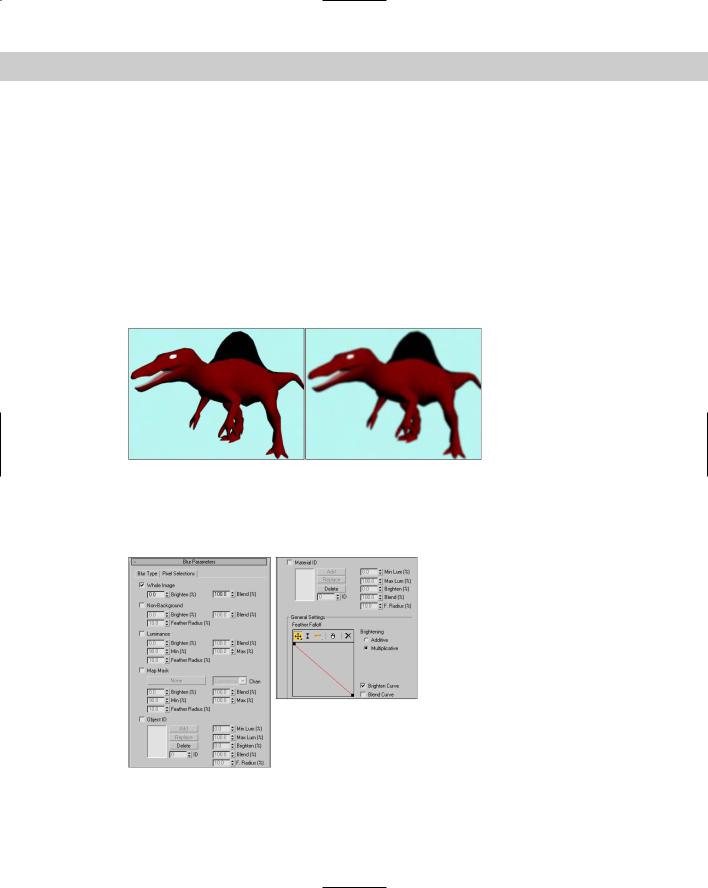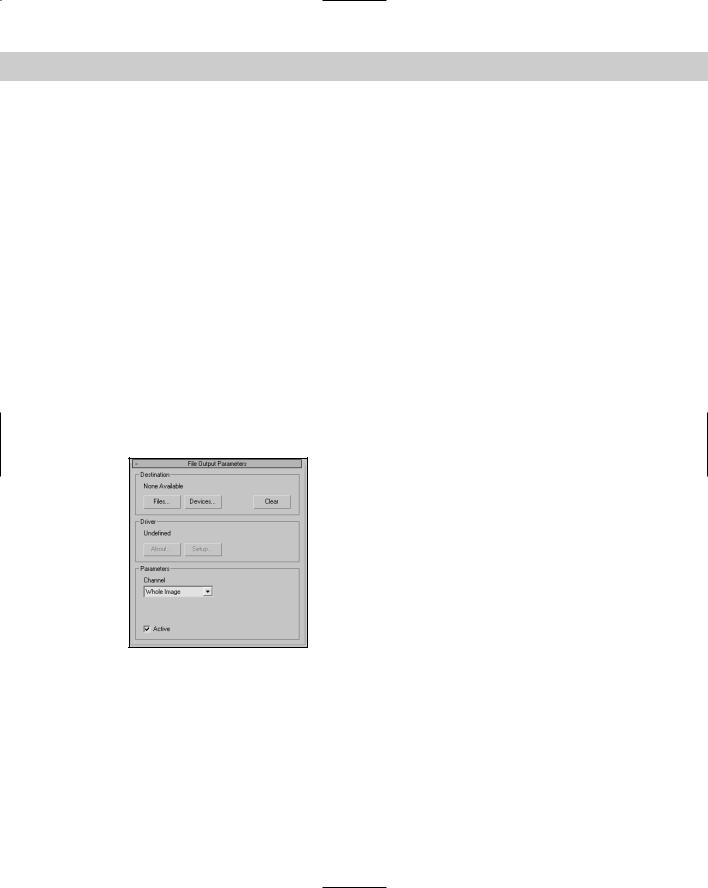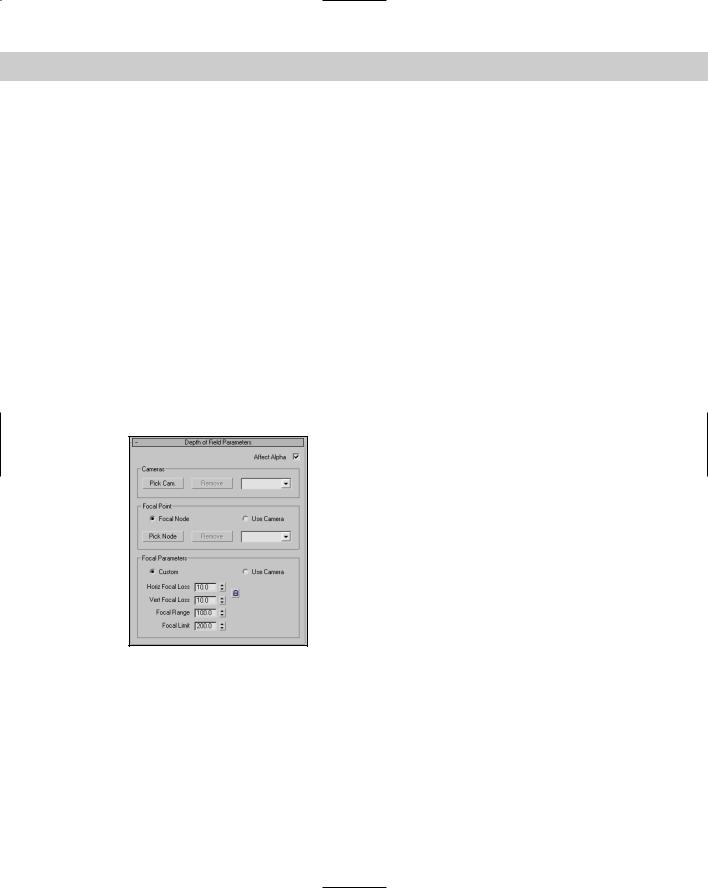
- •Preface
- •About This Book
- •Acknowledgments
- •Contents at a Glance
- •Contents
- •Relaxing at the Beach
- •Dressing the Scene
- •Animating Motion
- •Rendering the Final Animation
- •Summary
- •The Interface Elements
- •Using the Menus
- •Using the Toolbars
- •Using the Viewports
- •Using the Command Panel
- •Using the Lower Interface Bar Controls
- •Interacting with the Interface
- •Getting Help
- •Summary
- •Understanding 3D Space
- •Using the Viewport Navigation Controls
- •Configuring the Viewports
- •Working with Viewport Backgrounds
- •Summary
- •Working with Max Scene Files
- •Setting File Preferences
- •Importing and Exporting
- •Referencing External Objects
- •Using the File Utilities
- •Accessing File Information
- •Summary
- •Customizing Modify and Utility Panel Buttons
- •Working with Custom Interfaces
- •Configuring Paths
- •Selecting System Units
- •Setting Preferences
- •Summary
- •Creating Primitive Objects
- •Exploring the Primitive Object Types
- •Summary
- •Selecting Objects
- •Setting Object Properties
- •Hiding and Freezing Objects
- •Using Layers
- •Summary
- •Cloning Objects
- •Understanding Cloning Options
- •Mirroring Objects
- •Cloning over Time
- •Spacing Cloned Objects
- •Creating Arrays of Objects
- •Summary
- •Working with Groups
- •Building Assemblies
- •Building Links between Objects
- •Displaying Links and Hierarchies
- •Working with Linked Objects
- •Summary
- •Using the Schematic View Window
- •Working with Hierarchies
- •Setting Schematic View Preferences
- •Using List Views
- •Summary
- •Working with the Transformation Tools
- •Using Pivot Points
- •Using the Align Commands
- •Using Grids
- •Using Snap Options
- •Summary
- •Exploring the Modifier Stack
- •Exploring Modifier Types
- •Summary
- •Exploring the Modeling Types
- •Working with Subobjects
- •Modeling Helpers
- •Summary
- •Drawing in 2D
- •Editing Splines
- •Using Spline Modifiers
- •Summary
- •Creating Editable Mesh and Poly Objects
- •Editing Mesh Objects
- •Editing Poly Objects
- •Using Mesh Editing Modifiers
- •Summary
- •Introducing Patch Grids
- •Editing Patches
- •Using Modifiers on Patch Objects
- •Summary
- •Creating NURBS Curves and Surfaces
- •Editing NURBS
- •Working with NURBS
- •Summary
- •Morphing Objects
- •Creating Conform Objects
- •Creating a ShapeMerge Object
- •Creating a Terrain Object
- •Using the Mesher Object
- •Working with BlobMesh Objects
- •Creating a Scatter Object
- •Creating Connect Objects
- •Modeling with Boolean Objects
- •Creating a Loft Object
- •Summary
- •Understanding the Various Particle Systems
- •Creating a Particle System
- •Using the Spray and Snow Particle Systems
- •Using the Super Spray Particle System
- •Using the Blizzard Particle System
- •Using the PArray Particle System
- •Using the PCloud Particle System
- •Using Particle System Maps
- •Controlling Particles with Particle Flow
- •Summary
- •Understanding Material Properties
- •Working with the Material Editor
- •Using the Material/Map Browser
- •Using the Material/Map Navigator
- •Summary
- •Using the Standard Material
- •Using Shading Types
- •Accessing Other Parameters
- •Using External Tools
- •Summary
- •Using Compound Materials
- •Using Raytrace Materials
- •Using the Matte/Shadow Material
- •Using the DirectX 9 Shader
- •Applying Multiple Materials
- •Material Modifiers
- •Summary
- •Understanding Maps
- •Understanding Material Map Types
- •Using the Maps Rollout
- •Using the Map Path Utility
- •Using Map Instances
- •Summary
- •Mapping Modifiers
- •Using the Unwrap UVW modifier
- •Summary
- •Working with Cameras
- •Setting Camera Parameters
- •Summary
- •Using the Camera Tracker Utility
- •Summary
- •Using Multi-Pass Cameras
- •Creating Multi-Pass Camera Effects
- •Summary
- •Understanding the Basics of Lighting
- •Getting to Know the Light Types
- •Creating and Positioning Light Objects
- •Viewing a Scene from a Light
- •Altering Light Parameters
- •Working with Photometric Lights
- •Using the Sunlight and Daylight Systems
- •Using Volume Lights
- •Summary
- •Selecting Advanced Lighting
- •Using Local Advanced Lighting Settings
- •Tutorial: Excluding objects from light tracing
- •Summary
- •Understanding Radiosity
- •Using Local and Global Advanced Lighting Settings
- •Working with Advanced Lighting Materials
- •Using Lighting Analysis
- •Summary
- •Using the Time Controls
- •Working with Keys
- •Using the Track Bar
- •Viewing and Editing Key Values
- •Using the Motion Panel
- •Using Ghosting
- •Animating Objects
- •Working with Previews
- •Wiring Parameters
- •Animation Modifiers
- •Summary
- •Understanding Controller Types
- •Assigning Controllers
- •Setting Default Controllers
- •Examining the Various Controllers
- •Summary
- •Working with Expressions in Spinners
- •Understanding the Expression Controller Interface
- •Understanding Expression Elements
- •Using Expression Controllers
- •Summary
- •Learning the Track View Interface
- •Working with Keys
- •Editing Time
- •Editing Curves
- •Filtering Tracks
- •Working with Controllers
- •Synchronizing to a Sound Track
- •Summary
- •Understanding Your Character
- •Building Bodies
- •Summary
- •Building a Bones System
- •Using the Bone Tools
- •Using the Skin Modifier
- •Summary
- •Creating Characters
- •Working with Characters
- •Using Character Animation Techniques
- •Summary
- •Forward versus Inverse Kinematics
- •Creating an Inverse Kinematics System
- •Using the Various Inverse Kinematics Methods
- •Summary
- •Creating and Binding Space Warps
- •Understanding Space Warp Types
- •Combining Particle Systems with Space Warps
- •Summary
- •Understanding Dynamics
- •Using Dynamic Objects
- •Defining Dynamic Material Properties
- •Using Dynamic Space Warps
- •Using the Dynamics Utility
- •Using the Flex Modifier
- •Summary
- •Using reactor
- •Using reactor Collections
- •Creating reactor Objects
- •Calculating and Previewing a Simulation
- •Constraining Objects
- •reactor Troubleshooting
- •Summary
- •Understanding the Max Renderers
- •Previewing with ActiveShade
- •Render Parameters
- •Rendering Preferences
- •Creating VUE Files
- •Using the Rendered Frame Window
- •Using the RAM Player
- •Reviewing the Render Types
- •Using Command-Line Rendering
- •Creating Panoramic Images
- •Getting Printer Help
- •Creating an Environment
- •Summary
- •Creating Atmospheric Effects
- •Using the Fire Effect
- •Using the Fog Effect
- •Summary
- •Using Render Elements
- •Adding Render Effects
- •Creating Lens Effects
- •Using Other Render Effects
- •Summary
- •Using Raytrace Materials
- •Using a Raytrace Map
- •Enabling mental ray
- •Summary
- •Understanding Network Rendering
- •Network Requirements
- •Setting up a Network Rendering System
- •Starting the Network Rendering System
- •Configuring the Network Manager and Servers
- •Logging Errors
- •Using the Monitor
- •Setting up Batch Rendering
- •Summary
- •Compositing with Photoshop
- •Video Editing with Premiere
- •Video Compositing with After Effects
- •Introducing Combustion
- •Using Other Compositing Solutions
- •Summary
- •Completing Post-Production with the Video Post Interface
- •Working with Sequences
- •Adding and Editing Events
- •Working with Ranges
- •Working with Lens Effects Filters
- •Summary
- •What Is MAXScript?
- •MAXScript Tools
- •Setting MAXScript Preferences
- •Types of Scripts
- •Writing Your Own MAXScripts
- •Learning the Visual MAXScript Editor Interface
- •Laying Out a Rollout
- •Summary
- •Working with Plug-Ins
- •Locating Plug-Ins
- •Summary
- •Low-Res Modeling
- •Using Channels
- •Using Vertex Colors
- •Rendering to a Texture
- •Summary
- •Max and Architecture
- •Using AEC Objects
- •Using Architectural materials
- •Summary
- •Tutorial: Creating Icy Geometry with BlobMesh
- •Tutorial: Using Caustic Photons to Create a Disco Ball
- •Summary
- •mental ray Rendering System
- •Particle Flow
- •reactor 2.0
- •Schematic View
- •BlobMesh
- •Spline and Patch Features
- •Import and Export
- •Shell Modifier
- •Vertex Paint and Channel Info
- •Architectural Primitives and Materials
- •Minor Improvements
- •Choosing an Operating System
- •Hardware Requirements
- •Installing 3ds max 6
- •Authorizing the Software
- •Setting the Display Driver
- •Updating Max
- •Moving Max to Another Computer
- •Using Keyboard Shortcuts
- •Using the Hotkey Map
- •Main Interface Shortcuts
- •Dialog Box Shortcuts
- •Miscellaneous Shortcuts
- •System Requirements
- •Using the CDs with Windows
- •What’s on the CDs
- •Troubleshooting
- •Index

Chapter 43 Using Render Elements and Effects 1033
Figure 43-21: The Spruce Goose has had a sparkle added to it using the Glow and Star Lens Effects.
Using Other Render Effects
Now that the big brother of the render effects is covered, let’s return to the Add Effect dialog box where six other render effects are available. If these selections aren’t enough, Max also enables you to add even more options to this list via plug-ins.
Blur render effect
The Blur render effect displays three different blurring methods in the Blur Type panel: Uniform, Directional, and Radial. You can find these options in the Blur Type tabbed panel in the Blur Parameters rollout, shown in Figure 43-22.
Figure 43-22: The Blur Parameters rollout lets you select a Uniform, Directional, or Radial blur type.

1034 Part X Rendering
The Uniform blur method applies the blur evenly across the whole image. The Pixel Radius value defines the amount of the blur. The Directional blur method can be used to blur the image along a certain direction. The U Pixel Radius and U Trail values define the blur in the horizontal direction, and the V Pixel Radius and V Trail values blur in a vertical direction. The Rotation value rotates the axis of the blur.
The Radial blur method creates concentric blurred rings determined by the Radius and Trail values. When the Use Object Center option is selected, the None and Clear buttons become active. Clicking the None button lets you select an object about which you want to center the radial blur. The Clear button clears this selection.
Figure 43-23 shows a dinosaur model created by Viewpoint Datalabs. The actual rendered image shows the sharp edges of the polygons. The Blur effect can help this by softening all the hard edges. The left image is the original dinosaur, and the right image has a Directional blur applied.
Figure 43-23: The Blur effect can soften an otherwise hard model.
The Blur Parameters rollout also includes a Pixel Selections tabbed panel, shown in Figure 43-24, that contains parameters for specifying which parts of the image get blurred. Options include the Whole Image, Non-Background, Luminance, Map Mask, Material ID, and Object ID.
Figure 43-24: The Pixel Selections tabbed panel (shown in two parts) of the Blur Parameters rollout lets you select the parts of the image that get the Blur effect.

Chapter 43 Using Render Elements and Effects 1035
You can use the Feather Falloff curve at the bottom of the Blur Parameters rollout to define the Brighten and Blend curves. The buttons above this curve are for adding points, scaling, and moving them within the curve interface.
Brightness and Contrast render effect
The Brightness and Contrast render effect can alter these amounts in the image. The Brightness and Contrast Parameters rollout is a simple rollout with values for both the brightness and contrast, which can range from 0 to 1. It also contains an Ignore Background option.
Color Balance render effect
The Color Balance effect enables you to tint the image using separate Cyan/Red, Magenta/Green, and Yellow/Blue channels. To change the color balance, drag the sliders in the Color Balance Parameters rollout. Other options include Preserve Luminosity and Ignore Background. The Preserve Luminosity option tints the image while maintaining the luminosity of the image, and the Ignore Background option tints the rendered objects but not the background image.
File Output render effect
The File Output render effect enables you to save the rendered file to a File or to a Device at any point during the render effect’s post-processing. Figure 43-25 shows the File Output Parameters rollout.
Figure 43-25: The File Output Parameters rollout lets you save a rendered image before a render effect is applied.
Using the Channel drop-down list in the Parameters section, you can save out Whole Images, as well as grayscale Luminance, Depth, and Alpha images.

1036 Part X Rendering
Film Grain render effect
The Film Grain effect gives an image a grained look, which hardens the overall look of the image. You can also use this effect to match rendered objects to the grain of the background image. This helps the objects blend into the scene better.
The Grain value can range from 0 to 1. The Ignore Background option applies the grain effect to only the objects in the scene and not to the background.
Motion Blur render effect
The Motion Blur effect applies a simple image motion blur to the rendered output. The Motion Blur Parameters rollout includes settings for working with Transparency and a value for the Duration of the blur. Objects that move rapidly within the scene are blurred.
Depth of Field render effect
The Depth of Field effect enhances the sense of depth by blurring objects close to or far from the camera. The Pick Cam button in the Depth of Field Parameters rollout, shown in Figure 43-26, lets you select a camera in the viewport to use for this effect. Multiple cameras can be selected, and all selected cameras are displayed in the drop-down list. A Remove button lets you remove cameras.
Figure 43-26: The Depth of Field Parameters rollout lets you select a camera or a Focal Point to apply the effect to.
In the Focal Point section, the Pick Node button lets you select an object to use as the focal point. This object is where the camera focuses. Objects far from this object are blurred. These nodes are also listed in a drop-down list. You can remove objects from the list by selecting them and clicking the Remove button. The Use Camera option uses the camera’s own settings to determine the focal point.
